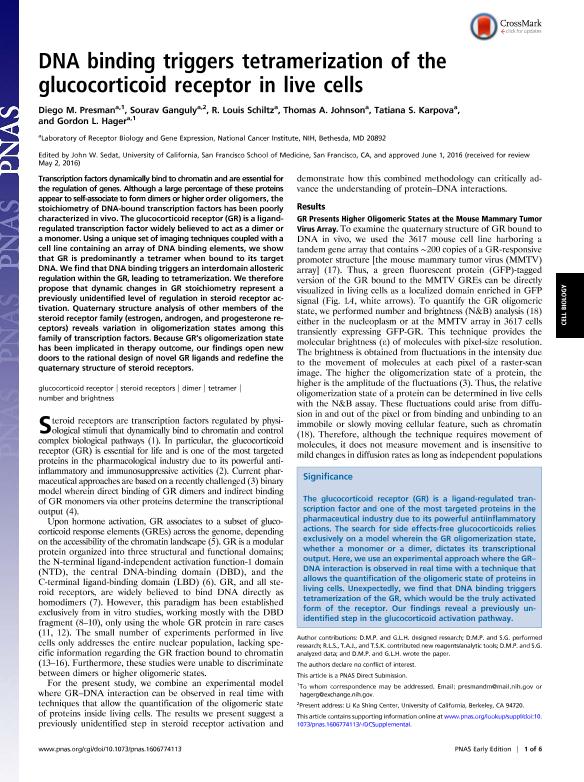Artículo
DNA binding triggers tetramerization of the glucocorticoid receptor in live cells
Presman, Diego Martin ; Ganguly, Sourav; Schiltz, R. Louis; Johnson, Thomas A.; Karpova, Tatiana S.; Hager, Gordon L.
; Ganguly, Sourav; Schiltz, R. Louis; Johnson, Thomas A.; Karpova, Tatiana S.; Hager, Gordon L.
 ; Ganguly, Sourav; Schiltz, R. Louis; Johnson, Thomas A.; Karpova, Tatiana S.; Hager, Gordon L.
; Ganguly, Sourav; Schiltz, R. Louis; Johnson, Thomas A.; Karpova, Tatiana S.; Hager, Gordon L.
Fecha de publicación:
07/2016
Editorial:
National Academy of Sciences
Revista:
Proceedings of the National Academy of Sciences of The United States of America
ISSN:
0027-8424
Idioma:
Inglés
Tipo de recurso:
Artículo publicado
Clasificación temática:
Resumen
Transcription factors dynamically bind to chromatin and are essential for the regulation of genes. Although a large percentage of these proteins appear to self-associate to form dimers or higher order oli gomers, t he stoichiometry of DNA-bound transcription factors has been poorly characterized in vivo. The glucocorticoid receptor (GR) is a ligandregulated transcription factor widely believed to act as a dimer or a monomer. Using a unique set of imaging techniques coupled with a cell line containing an array of DNA binding elements, we show that GR is predominantly a tetramer when bound to its target DNA. We find that DNA binding triggers an interdomain allosteric regulation within the GR, leading to tetramerization. We therefore propose that dynamic changes in GR stoichiometry represent a previously unidentified level of regulation in steroid receptor activation. Quaternary structure analysis of other members of the steroid receptor family (estrogen, androgen, and progesterone receptors) reveals variation in oligomerization states among this family of transcription factors. Because GR's oligomerization state has been implicated in therapy outcome, our findings open new doors to the rational design of novel GR ligands and redefine the quaternary structure of steroid receptors.
Archivos asociados
Licencia
Identificadores
Colecciones
Articulos(IFIBYNE)
Articulos de INST.DE FISIOL., BIOL.MOLECULAR Y NEUROCIENCIAS
Articulos de INST.DE FISIOL., BIOL.MOLECULAR Y NEUROCIENCIAS
Citación
Presman, Diego Martin; Ganguly, Sourav; Schiltz, R. Louis; Johnson, Thomas A.; Karpova, Tatiana S.; et al.; DNA binding triggers tetramerization of the glucocorticoid receptor in live cells; National Academy of Sciences; Proceedings of the National Academy of Sciences of The United States of America; 113; 29; 7-2016; 8236-8241
Compartir
Altmétricas



